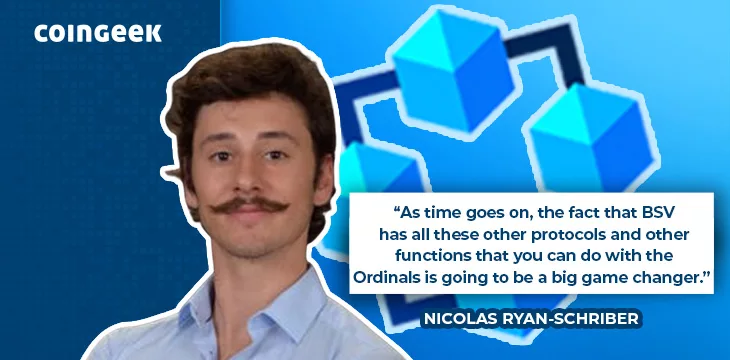|
Getting your Trinity Audio player ready...
|
On June 28, Joshua Henslee hosted the CoinGeek Roundtable on 1sat Ordinals. He was joined by Nicolas Ryan-Schriber, Jad Wahab, and David Case. What transpired was a lively discussion on Ordinals, why the BSV blockchain will be the superior chain to build on in the long run, what Ordinal Locks are, and more.
Note: for the purposes of this conversation, Joshua Henslee is asking the questions, and the other guests are answering them. Where viewers have asked questions, this has been indicated.
Why build on Ordinals?
Ryan-Schriber says his aim has always been to build an image marketplace. He planned to build on RUN, but that’s no longer possible. Happily, as it shut down, Ordinals took off on BTC, and the participants in this roundtable and others brought it to the BSV blockchain.
Wahab answers that while he’s been helping with the technical side of things, he’s more interested in the non-technical impacts of all of this. Ordinals is an on-chain economy, and a snowball effect is underway that will only gain momentum.
Case explains that he was involved in RUN. He spotted Ordinals on BTC. He says the main reason to build on it is pure Bitcoin; rather than being a totally new protocol, it’s just a way of indexing individual sats.
What are the differences between Ordinals on BSV blockchain and BTC?
Wahab says that, right now, there aren’t huge differences. People have just been trying to mirror what’s happening on BTC and ride the wave. It’s roughly the same.
Case says the main difference is that BTC is “very limited.” Ordinals are only possible because of a hack, and their work is convoluted and complex. BSV blockchain offers a much simpler, cheaper, and easier way to do things.
The liquidity is dominant on BTC. Why build Aym on BSV blockchain?
Ryan-Schriber says that BSV Ordinals are simply better because of the other functions of the blockchain and what you can do with Ordinals on it. So far, the BSV blockchain has been mirroring BTC, but that will change rapidly now.
Aym’s long-term plans require the BSV blockchain’s capabilities. They’re taking a longer-term approach and building where their bigger vision can be fulfilled. So much more can be done with Bitcoin script, he tells us.
Case echoes this sentiment, saying that builders on the BSV blockchain are already doing things that BTC can’t even imagine, and so far, they’re only scratching the surface.
Wahab agrees in general; while things have mirrored what’s happening on BTC so far, BSV blockchain builders need to innovate and demonstrate what the blockchain is capable of. There’s nothing wrong with taking ideas from BTC and doing them better, but BSVers have to do their own thing, too.
Aym is moving fast. How easy was it to pick up and run with things?
Ryan-Schriber thanks Henslee for the compliment and says he had a lucky advantage; as a relative newcomer, he wasn’t bogged down by ideas from the past. In fact, he didn’t even know how things had been done before. He just built things the way he thought they should be.
Case says that working with Aym has been a whirlwind. As far as process goes, there has been a lot of throwing ideas around, moving quickly when an opportunity presents itself, and trying ideas. While there’s no official roadmap, there’s much more to come.
What is Ordinal Lock?
Viewer Alex Vidal asks this question. Wahab explains it from a non-technical perspective; it allows for a global marketplace on the blockchain. Anyone can create their own front end and pull from the same neutral data layer. This will eliminate the gatekeeper layer controlled by the likes of YouTube today.
Ryan-Schriber elaborates on the implications. For example, he says that if you list something on one real estate platform, all the others can pull from the same on-chain data and list it. Therefore, from a user point of view, there’s a huge benefit.
Case explains that it’s a straightforward Bitcoin script; you’re locking your output,e.g., an NFT. You can unlock it if you’re the person who listed it by unlisting it, or anyone who pays a specified amount to a specified address can unlock it.
Why (or why not) rally around a single token protocol?
Wahab says that, by watching protocols like BRC-20 on BTC, we can see that the technical side doesn’t seem to matter much to users. People are what counts, and the network effect matters a great deal.
Case says that getting people to agree on basic concepts like what inscriptions or NFTs are is good. This allows innovation, e.g., BitMap, to occur. Everyone can build in the same direction once these basic things are agreed on.
Why keep building on BSV blockchain when the liquidity is better elsewhere?
Ryan-Schriber states his belief that liquidity will follow value. BSV Ordinals can offer that extra value, and as BSV 1sat Ordinals become better than those on BTC, people will follow. The dogma seen elsewhere in the industry doesn’t really apply in Ordinals. He describes those Ordinals as nomadic in nature.
Case says it isn’t Ordinals on BTC vs. on BSV; this is a cross-chain thing. If the tools work and allow users to do what they want, they’ll use them. He says there is room for interoperability between chains, and content can even cross chains.
To learn more about each roundtable participant’s thoughts on 1Sat Ordinals, what indexers are, whether cross-chain communication might be possible, and more, watch the roundtable via the video link above!
Watch: Ordinals on BSV! Luke Rohenaz explains their Utility and Value on the CoinGeek Weekly Livestream

 08-26-2025
08-26-2025 





